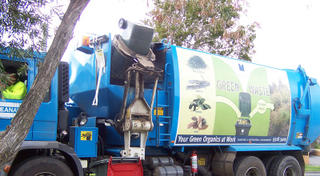 Hi... pagi ini aku baca emailku , dan tiba2 aku di sapa dg ''D'' lewat yahoo messenger.Dia bertanya apa sampah itu di sini juga di buat kotak2, dan di daur ulang. Aku bilang iya. Dan aku tau sekarang ini Indonesia lagi ribut2 masalah sampah. Dan di JKT ada pabrik sampah yang di protes dg Masyarakat. MmM aku tanya kok di protes sih, kan bagus, sampahnya di daur ulang, membuka lapangan kerja baru.'' D'' berkata Indonesia itu harus di daur ulang juga, di hancurkan dan buat baru lagi. Banyak orang yang belom paham, masalahnya itu dr kepahaman masyarakat sendiri, dan bukan sampahnya.
Hi... pagi ini aku baca emailku , dan tiba2 aku di sapa dg ''D'' lewat yahoo messenger.Dia bertanya apa sampah itu di sini juga di buat kotak2, dan di daur ulang. Aku bilang iya. Dan aku tau sekarang ini Indonesia lagi ribut2 masalah sampah. Dan di JKT ada pabrik sampah yang di protes dg Masyarakat. MmM aku tanya kok di protes sih, kan bagus, sampahnya di daur ulang, membuka lapangan kerja baru.'' D'' berkata Indonesia itu harus di daur ulang juga, di hancurkan dan buat baru lagi. Banyak orang yang belom paham, masalahnya itu dr kepahaman masyarakat sendiri, dan bukan sampahnya. MmMm ini ada artikel yang aku cari di Internet ( kalo masuk di Wikipedia ) kalian juga bisa rubah bahasanya dalam bhs Indonesia. Aku harap bermanfaat deh.
WASTE
 For other uses of the word, see Waste (disambiguation).
For other uses of the word, see Waste (disambiguation).This article needs to be cleaned up to conform to a higher standard of quality.See How to Edit and Style and How-to for help, or this article's talk page.
Waste inside a trash can
Waste is unwanted or undesired material left over after the completion of a process.
Waste can exist in any phase of matter (solid, liquid, or gas). When released in the latter two states, gas especially, the wastes are referred to as emissions. It is usually strongly linked with pollution.
Contents[hide]
1 Sources of waste
2 Human waste
3 See also
4 References
Sources of waste
 Sources of waste for European Environment Agency countries, 1992-1997.
Sources of waste for European Environment Agency countries, 1992-1997.Waste produced in the wild is reintegrated through natural recycling processes, such as dry leaves in a forest decomposing into soil. Outside of the wild these wastes may become problematic, such as dry leaves in an urban environment. The highest volume of waste, outside of nature, comes from human industrial activity: mining, industrial manufacture, consumer use, and so on1. Almost all manufactured products are destined to become waste at some point in time, with a volume of waste production roughly similar to the volume of resource consumption.
Post-consumer waste is the waste produced by the end-user (the garbage one puts outside in the trash can). This is the waste people usually think of. But though the most visible, this is very small compared to the waste created in the process of mining and production.
Human waste
 Melbourne Organic Waste Collection Truck
Melbourne Organic Waste Collection Trucklandfill
Human waste is a term in the English language usually used to refer to byproducts of digestion, such as feces and urine. Human waste can be a serious health hazard, as it is a good vector for both viral and bacterial diseases. A major accomplishment of human civilization has been the reduction of disease transmission via human waste through the practice of hygiene and sanitation, including the development of theories of sewage systems and plumbing. Human waste can be reduced and reused through use of greywater, waterless urinals and humanure systems. In very rural places without sewage systems, small populations allow for the continued use of honey buckets and sewage lagoons without the threat of disease presented by places with more dense populations.
See also
Waste disposal
Nuclear waste
Incineration
References
This page contains material imported from please see the history of the original article. The original material was licensed under the GFDL v 1.2.
Total waste generation by sector - EEA Countries 1992-1997, European Environmental Agency, retrieved 2005/01/05.
1 comment:
Wah bagus juga neh tulisannya.
Ngomong2 masalah sampah, aku jadi inget temenku Petrus, anak surabaya yg juga dpt beasiswa Prancis. Aku baru saja datang dari bandara nganter dia.
Nah Petrus ini, sekarang kuliah di Université Lille 3, ngambil manajemen sampah. Dan hebatnya lagi, semester ini dia bisa jadi ranking II di kelasnya!
Rencananya dia di Indonesia dan surabaya selama 1 bulan, cari data plus buat proyek dengan PEMKOT.
Ada saran buat dia?
Post a Comment